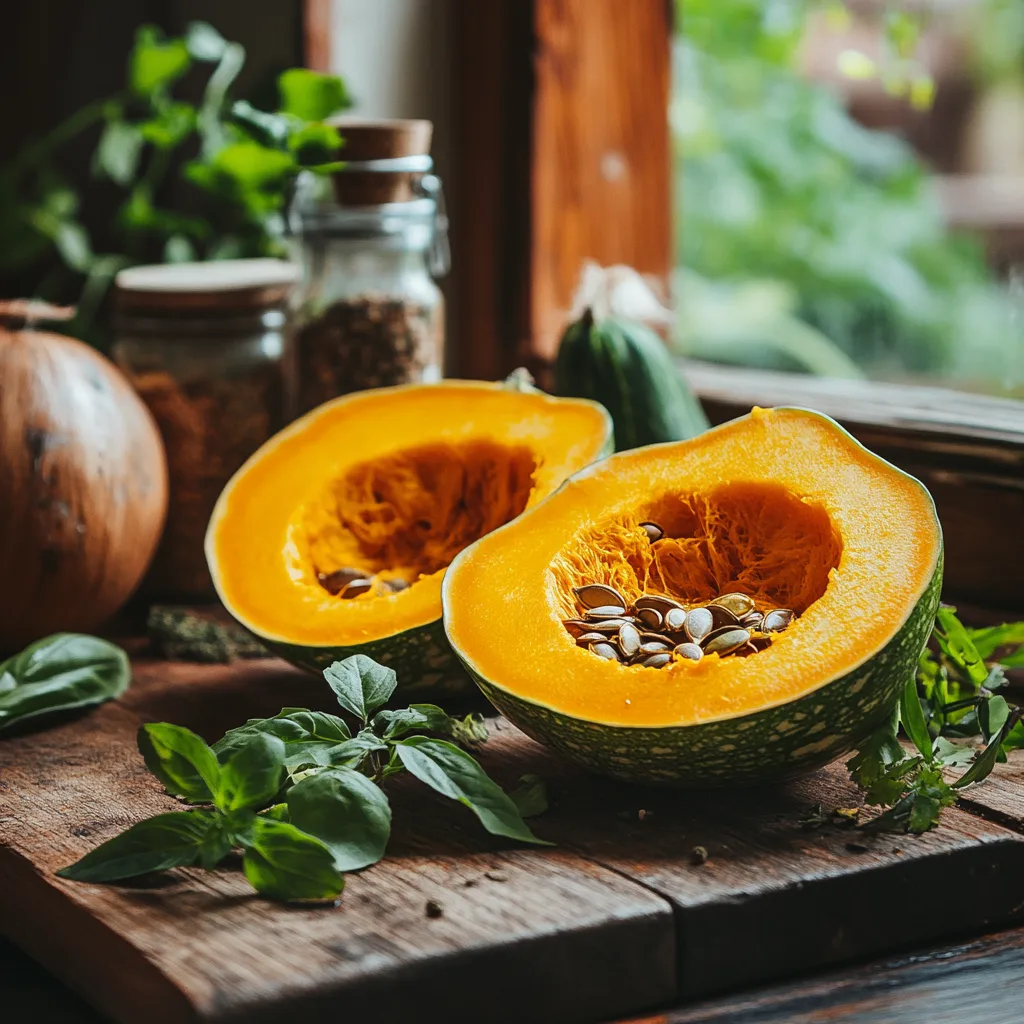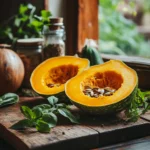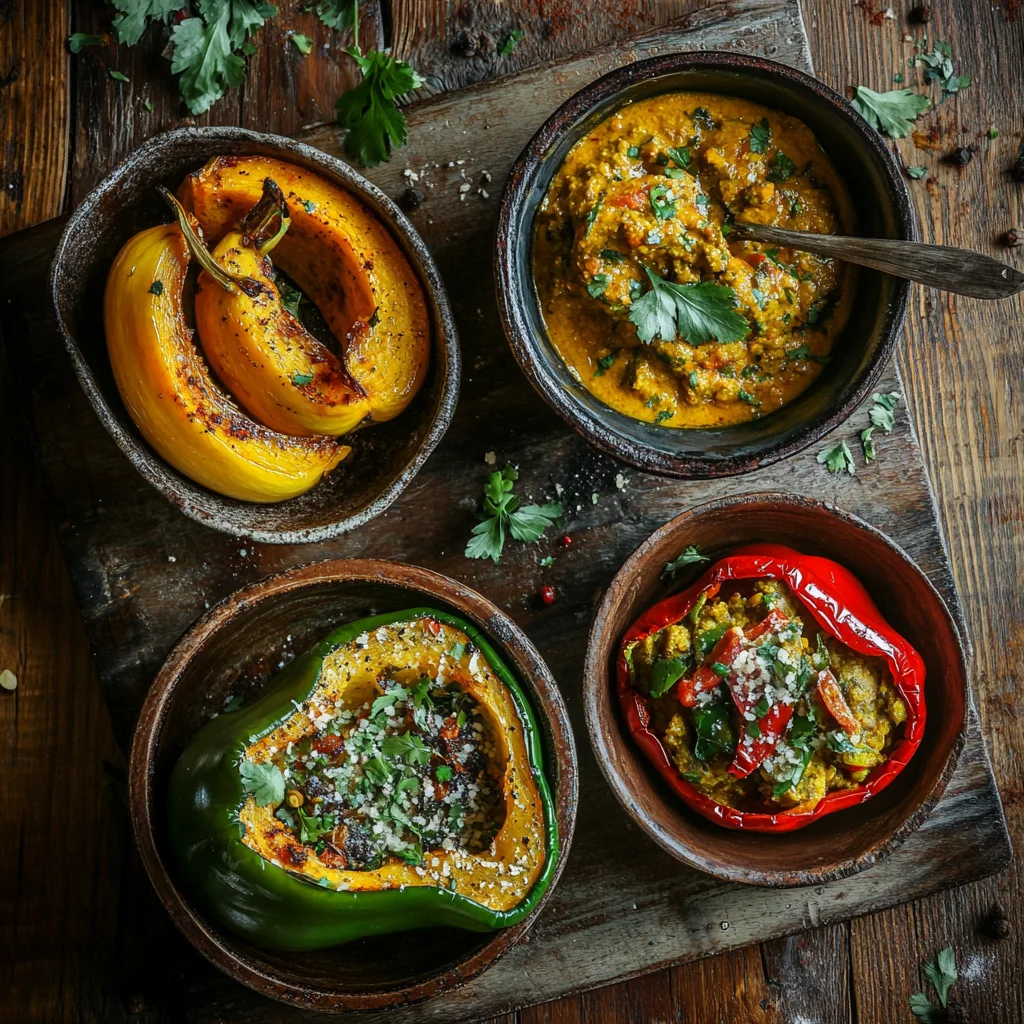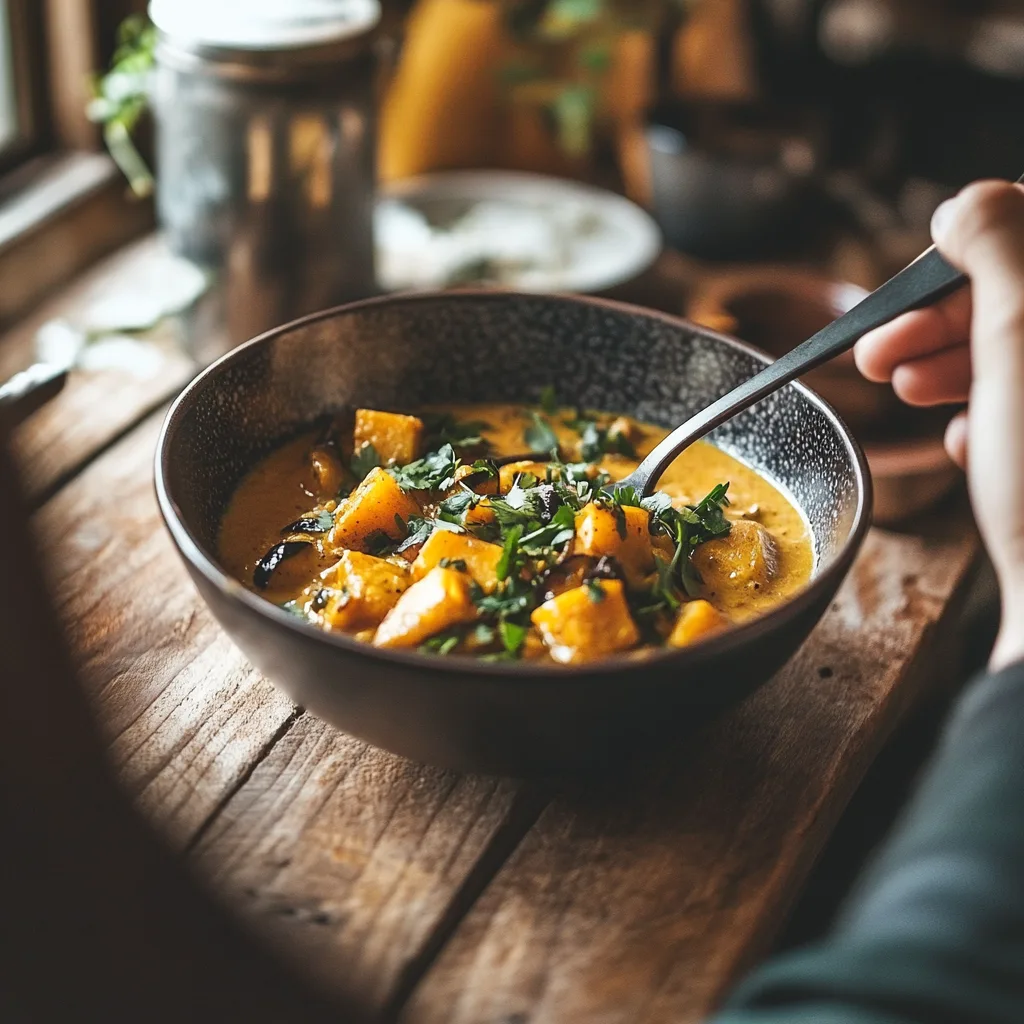
Hey there, fellow food adventurers! Are you ready to dive into the wonderful world of kabocha squash? If you’re anything like me, you’re always on the lookout for easy Chinese squash recipes that are not only vegan but also bursting with flavor. This vibrant green squash is a game-changer, offering a naturally sweet and nutty flavor that pairs beautifully with both traditional and modern Chinese-inspired vegan dishes.
Kabocha squash is incredibly versatile, making it perfect for creating everything from comforting soups to stir-fries and hearty stews. Whether you’re a seasoned vegan cook or just starting to explore plant-based options, these easy Chinese squash recipes will make cooking with kabocha squash a breeze.
So buckle up and get ready to fall in love with this humble squash as we transform it into delicious, plant-based masterpieces. With these kabocha vegan recipes, your kitchen will become a playground for culinary creativity!
Print
Easy and Tasty Vegan Kabocha Squash Recipes for Every Cook
- Total Time: 35-40 minutes
- Yield: 4 servings 1x
- Diet: Vegan
Description
A classic dish combining the sweetness of maple syrup, the zing of ginger, and the nutty flavor of kabocha into a truly spectacular dish.
Ingredients
- 1 medium kabocha squash, cut into wedges
- 2 tablespoons olive oil
- 2 tablespoons maple syrup
- 1 tablespoon fresh ginger, grated
- Salt and black pepper to taste
Instructions
- Preheat your oven to 400°F (200°C).
- Toss the kabocha wedges with olive oil, salt, and pepper.
- Arrange the wedges in a single layer on a baking sheet.
- In a small bowl, whisk together the maple syrup and grated ginger.
- Drizzle the glaze over the squash.
- Roast for 25-30 minutes, or until the squash is tender and slightly caramelized.
- Prep Time: 10 minutes
- Cook Time: 25-30 minutes
- Category: Side Dish, Appetizer
- Method: Roasting
- Cuisine: Fusion (Chinese inspired with global flavors)
Nutrition
- Serving Size: 1 wedge
- Calories: 150-200
- Sugar: Moderate, from maple syrup
- Sodium: Low
- Fat: from olive oil
Keywords: Kabocha Squash, Roasted, Vegan, Maple, Ginger, Side Dish, Easy, Chinese Inspired
Why Kabocha Squash is Perfect for Easy Chinese Squash Recipes and Vegan Cooking
Okay, let’s talk about why kabocha squash is basically the rockstar of the vegan kitchen. It’s not just another veggie; it’s a game-changer! It’s packed with goodness and tastes incredible. What’s not to love?
Nutritional Powerhouse
Hey there, fellow food adventurers! Are you ready to dive into the wonderful world of kabocha squash? If you’re anything like me, you’re always on the lookout for easy Chinese squash recipes that are not only vegan but also bursting with flavor. This vibrant green squash is a game-changer, offering a naturally sweet and nutty flavor that pairs beautifully with both traditional and modern Chinese-inspired vegan dishes.
When it comes to creating easy Chinese squash recipes, kabocha squash is incredibly versatile. From comforting soups to stir-fries and hearty stews, this ingredient fits seamlessly into a variety of plant-based meals. Whether you’re a seasoned vegan cook or just beginning to explore kabocha vegan recipes, you’ll love how effortlessly it transforms your dishes.
So buckle up and get ready to fall in love with this humble squash. With these easy Chinese squash recipes kabocha vegan, your kitchen will become a playground for culinary creativity! Let’s embark on this delicious adventure and uncover the magic of kabocha together.
Versatility in the Kitchen
But wait, there’s more! Beyond the nutritional benefits, kabocha is a total chameleon in the kitchen. Think about it: you can roast it, puree it into a creamy soup, turn it into a hearty curry, or even bake it into delicious vegan desserts. It can be the star of a dish or a supporting character, adapting beautifully to different flavors and textures. Unlike other squashes, it maintains its structure well, so you can cook it in various ways without it turning to mush. This means it is amazing in curries and stews where you don’t want it dissolving into the sauce. This versatility is what makes kabocha a staple in my vegan kitchen—I can literally make different meals every time I buy one.
“Kabocha squash is truly one of nature’s most versatile gifts. Its ability to adapt to sweet and savory dishes makes it a staple for plant-based eaters and beyond.”
The beauty of kabocha is that its natural sweetness is not overpowering; it has a subtle nutty flavor that complements both sweet and savory dishes perfectly. Its flesh is firm yet tender, and when cooked, it has an almost melt-in-your-mouth texture that is absolutely divine! So, whether you’re craving a cozy winter warmer or something light and refreshing, kabocha has got your back.
Getting Started: Preparing Kabocha for Easy Chinese Squash Recipes and Vegan Dishes
Before we jump into the delicious recipes, let’s talk about selecting and prepping your kabocha squash. This part is crucial because a good squash and proper prep are the first steps to a successful and scrumptious meal. Think of it as laying the foundation for your flavor masterpiece! 🏗️
Selecting the Perfect Kabocha
So, how do you pick the perfect kabocha? It’s not rocket science, but there are a few things to keep in mind. First, look for a squash that feels heavy for its size. This indicates that it’s dense and full of that delicious, sweet flesh we’re after. The skin should be a deep, vibrant green with minimal blemishes. A few small scratches are fine, but avoid squashes with soft spots or bruises, as these can indicate that the squash isn’t at its peak ripeness. The stem should also be firm and dry, not soft or moldy. And finally, give it a little tap – it should sound hollow. If it sounds dull, it might be too ripe or have some internal issues. Don’t worry, you’ll get the hang of it with a little practice! It’s like choosing the perfect avocado; once you know what to look for, it becomes second nature.
Simple Prep Techniques
Now, let’s talk prep. One of the most common questions about kabocha is how to cut it without needing a chainsaw. Yes, it can be a bit intimidating, but here’s a simple method that makes it manageable:
- Wash it: First things first, give your kabocha a good wash under cold water. You’ll be cooking the skin on in some recipes, so it’s important to start clean.
- Microwave Assist: This step is optional, but it can make a HUGE difference. Poke the squash a few times with a fork (like you’re letting off some steam) and microwave it for 2-3 minutes. This softens the skin and makes cutting a whole lot easier.
- Careful Cutting: Use a sharp chef’s knife, and slice off both ends of the squash to create a flat surface. Then, carefully slice the squash in half vertically from the top to the bottom. Once it’s halved, use a spoon to scoop out the seeds and stringy bits, just like you would with a pumpkin.
- Cut as needed: From here, you can cut the kabocha into slices, cubes, or wedges, depending on your recipe. If the squash is still too hard to manage, you can add a minute or two more in the microwave.
See? It’s not that scary after all! The microwave trick is the game changer here, trust me.

Top 3 Easy Chinese Squash Recipes: Vegan Kabocha Dishes
Alright, we’ve made it to the fun part! Here are three incredibly easy and delicious vegan recipes that highlight the amazing flavors and versatility of kabocha squash:
Roasted Kabocha with Maple-Ginger Glaze
This is a classic for a reason. The sweetness of the maple syrup, the zing of ginger, and the nutty flavor of the kabocha combine into a truly spectacular dish.
- Ingredients:
- 1 medium kabocha squash, cut into wedges
- 2 tablespoons olive oil
- 2 tablespoons maple syrup
- 1 tablespoon fresh ginger, grated
- Salt and black pepper to taste
- Instructions:
- Preheat your oven to 400°F (200°C).
- Toss the kabocha wedges with olive oil, salt, and pepper.
- Arrange the wedges in a single layer on a baking sheet.
- In a small bowl, whisk together the maple syrup and grated ginger.
- Drizzle the glaze over the squash.
- Roast for 25-30 minutes, or until the squash is tender and slightly caramelized.
Creamy Kabocha Curry with Coconut Milk
This curry is the perfect weeknight meal – it’s comforting, flavorful, and incredibly easy to make.
- Ingredients:
- 1 medium kabocha squash, cubed
- 1 tablespoon coconut oil
- 1 onion, chopped
- 2 cloves garlic, minced
- 1 inch ginger, grated
- 1 teaspoon curry powder
- 1/2 teaspoon turmeric
- 1 can (14 oz) coconut milk
- 1 cup vegetable broth
- Salt and pepper to taste
- Fresh cilantro for garnish
- Instructions:
- Heat the coconut oil in a large pot or Dutch oven.
- Add the onion and cook until softened, about 5 minutes.
- Add the garlic and ginger, and cook for 1 minute more.
- Stir in the curry powder and turmeric, and cook for 30 seconds until fragrant.
- Add the kabocha cubes, coconut milk, and vegetable broth.
- Bring to a simmer, then reduce the heat and cook for 20-25 minutes, or until the squash is tender.
- Season with salt and pepper to taste, garnish with fresh cilantro and serve.
Kabocha and Chickpea Stuffed Peppers
This dish is a beautiful and healthy way to enjoy kabocha, packed with flavor and texture.
- Ingredients:
- 2 large bell peppers, any color
- 1 medium kabocha squash, cubed
- 1 can (15 oz) chickpeas, rinsed and drained
- 1/2 cup cooked quinoa or rice
- 1/4 cup vegetable broth
- 1/4 cup chopped red onion
- 1 clove garlic, minced
- 1 tablespoon olive oil
- 1 teaspoon smoked paprika
- Salt and pepper to taste
- Fresh parsley for garnish
- Instructions:
- Preheat your oven to 375°F (190°C).
- Cut the bell peppers in half lengthwise, remove the seeds and membranes.
- In a large pan, heat the olive oil, add the red onion and garlic and cook for 2-3 minutes.
- Add the squash cubes, chickpeas, paprika, vegetable broth, salt and pepper, and simmer for 10 minutes or until squash is tender.
- Mix in the cooked quinoa or rice.
- Stuff the pepper halves with the squash mixture.
- Bake for 20-25 minutes, or until the peppers are tender.
- Garnish with fresh parsley and serve.
Alright, let’s wrap up our kabocha journey with Part 3! We’ve covered the basics, shared some delicious recipes, and now it’s time to tackle some common hurdles and explore some fun variations. Let’s get to it!
Common Problems and Solutions for Easy Chinese Squash Recipes with Kabocha Vegan Cooking
Even the best cooks run into a few bumps in the road sometimes. Cooking with kabocha squash is usually a breeze, but there are a few common issues people encounter. Don’t worry; we’re here to help you troubleshoot!
Squash is Too Hard to Cut
We touched on this briefly earlier, but it’s worth revisiting because it’s probably the most common complaint. The thick skin of the kabocha can be a real challenge if you’re not prepared. The solution? As we mentioned earlier, a short stint in the microwave can work wonders. Microwaving it for a few minutes will soften the skin just enough to make slicing it much easier without precooking it too much. If you don’t have a microwave or prefer not to use one, you can also try poking holes in the squash and placing it in a preheated oven for about 10 minutes to achieve a similar result. Always ensure you use a very sharp chef’s knife for best results, as dull knives are not only ineffective but also more dangerous.
My Squash is Bland
Okay, so your kabocha came out tasting a little flat? Don’t worry, that just means it’s time to amp up the flavor! Kabocha has a naturally sweet, nutty taste, but it can be subtle. The key is to add the right spices and seasonings to bring out its best. For savory dishes, try using warming spices like cumin, coriander, smoked paprika, or a touch of chili. A little garlic and onion are also your friends. Don’t be afraid to experiment with different herbs and spice blends. If you’re going for a sweet dish, consider using cinnamon, nutmeg, ginger, or a hint of cloves. Adding a little sweetness with maple syrup, agave, or coconut sugar can also help enhance the natural sweetness of the squash and make it sing. A splash of lemon juice or vinegar can help balance flavors, creating a more dynamic taste profile.
The Skin is Too Tough to Eat
Here’s a fun fact: kabocha squash skin is edible, and when cooked properly, it’s quite tasty! However, I get it, sometimes it can be a bit tough and not the most pleasant texture. If the skin bothers you, here are a few tips. First, ensure you are roasting or cooking your kabocha long enough. The skin will become more tender with proper cooking time. Second, you can always peel it if it is your preference. If you want to remove the skin, try using a sharp vegetable peeler after the squash has been microwaved for a few minutes, as this will be easier than trying to peel it when raw. Another tip is to cut the kabocha into smaller cubes or wedges. Smaller pieces cook faster, and the skin softens more evenly. Lastly, if the texture of the skin is still not your thing, simply scoop out the flesh after cooking, and enjoy only the insides, and don’t worry, you’ll still have a delicious dish!
Tips for Perfecting Easy Chinese Squash Recipes with Kabocha Vegan Dishes
Alright, let’s move on to some tips that will help you take your kabocha dishes to the next level!
Roasting Techniques for Enhanced Flavor
Roasting kabocha is one of the best ways to bring out its natural sweetness and nutty flavor. Here are a few tips for perfecting your roasting game:
- High Heat: Don’t be afraid to crank up the heat. Roasting at 400°F (200°C) or higher helps caramelize the natural sugars in the squash, giving it a richer, more complex flavor.
- Even Slices: Ensure your kabocha pieces are cut into roughly the same size. This ensures they cook evenly, and you won’t have some pieces that are mushy while others are still hard.
- Don’t Overcrowd: Give your squash pieces some breathing room on the baking sheet. Overcrowding can lead to steaming instead of roasting, which will result in a less flavorful and less caramelized squash.
- Oil is Your Friend: Don’t skimp on the oil! A good quality olive oil or coconut oil will help the squash crisp up beautifully.
Spice it Up: Flavor Combinations That Shine
Kabocha squash is like a blank canvas, ready to absorb all sorts of exciting flavors. Here are a few of my favorite flavor combinations:
- Sweet and Spicy: Maple syrup, ginger, a pinch of red pepper flakes, and a touch of cinnamon.
- Savory and Earthy: Cumin, coriander, garlic, and a squeeze of lemon juice.
- Mediterranean Vibes: Olive oil, garlic, oregano, and a sprinkle of feta cheese (vegan, of course!).
- Indian Spices: Curry powder, turmeric, ginger, and coconut milk.
The key here is to experiment and find combinations that you love! Don’t be afraid to play around with different herbs and spices to create your perfect flavor profile.
Storage and Leftover Ideas
So, you’ve cooked up a storm, and now you have leftovers? No problem! Here are a few storage tips and ideas for repurposing your cooked kabocha:
- Storage: Cooked kabocha will keep in an airtight container in the fridge for 3-4 days. You can also freeze it for longer storage.
- Soup it Up: Turn leftover roasted kabocha into a creamy soup by blending it with vegetable broth and your favorite seasonings.
- Hash it Out: Dice up leftover roasted kabocha and add it to a breakfast hash with some potatoes, onions, and your favorite veggies.
- Salad Star: Use roasted or cooked kabocha in a vibrant salad with some greens, nuts, and a light vinaigrette.

Beyond the Basics: Variations and Inspirations for Easy Chinese Squash Recipes with Kabocha Vegan Ideas
Let’s get a little more creative and see what else we can do with this amazing squash!
Kabocha in Desserts? Yes, You Can!
You might be surprised to learn that kabocha makes a fantastic addition to sweet treats. Its natural sweetness and creamy texture make it perfect for:
- Vegan Pie: Use pureed kabocha as a base for a delicious and nutritious pie.
- Muffins and Breads: Add pureed kabocha to your favorite muffin or bread recipes for a moist and flavorful twist.
- Pancakes: Mix pureed kabocha into your pancake batter for a delightful weekend brunch treat.
Exploring International Kabocha Recipes
Kabocha squash is enjoyed all over the world, and each culture has its unique way of preparing it. Get inspired by:
- Japanese Cuisine: Try making tempura kabocha or simmered kabocha in a sweet soy broth.
- Thai Inspired Dishes: Add kabocha to a creamy red curry for a hearty and fragrant dish.
- Italian Delights: Use kabocha puree in ravioli or gnocchi for a unique and delicious experience.
“The world of kabocha squash is vast and full of possibilities. Don’t be afraid to explore and make each dish your own.”
Expanding Your Culinary Horizons Beyond Kabocha
While kabocha squash is a fantastic ingredient for vegan dishes, it’s always fun to explore other culinary avenues. If you’re looking to diversify your cooking repertoire, why not try your hand at preparing a delicate and flavorful fish dish like our Ultimate Branzino Recipe? Or perhaps you’re in the mood for something sweet and traditional, in which case our guide on How to Eat Red Bean Rice Balls might be just the ticket. For another easy and versatile plant-based option, consider exploring our simple Easy Tauhu Recipe. These recipes offer a great way to broaden your cooking skills and discover new flavors, complementing your kabocha-focused adventures in the kitchen.
Final Thoughts: Embracing the Wonderful World of Easy Chinese Squash Recipes with Kabocha Vegan Creations
Well, there you have it, my friends! We’ve explored the wonderful world of kabocha squash, from its amazing nutritional benefits to its incredible versatility in the kitchen. I hope you’re inspired to start experimenting with these recipes and create your own kabocha masterpieces. This humble squash has so much to offer, and it’s truly a gift for any vegan or plant-based eater. So grab a kabocha, get into the kitchen, and let the culinary adventure begin! Happy cooking!
